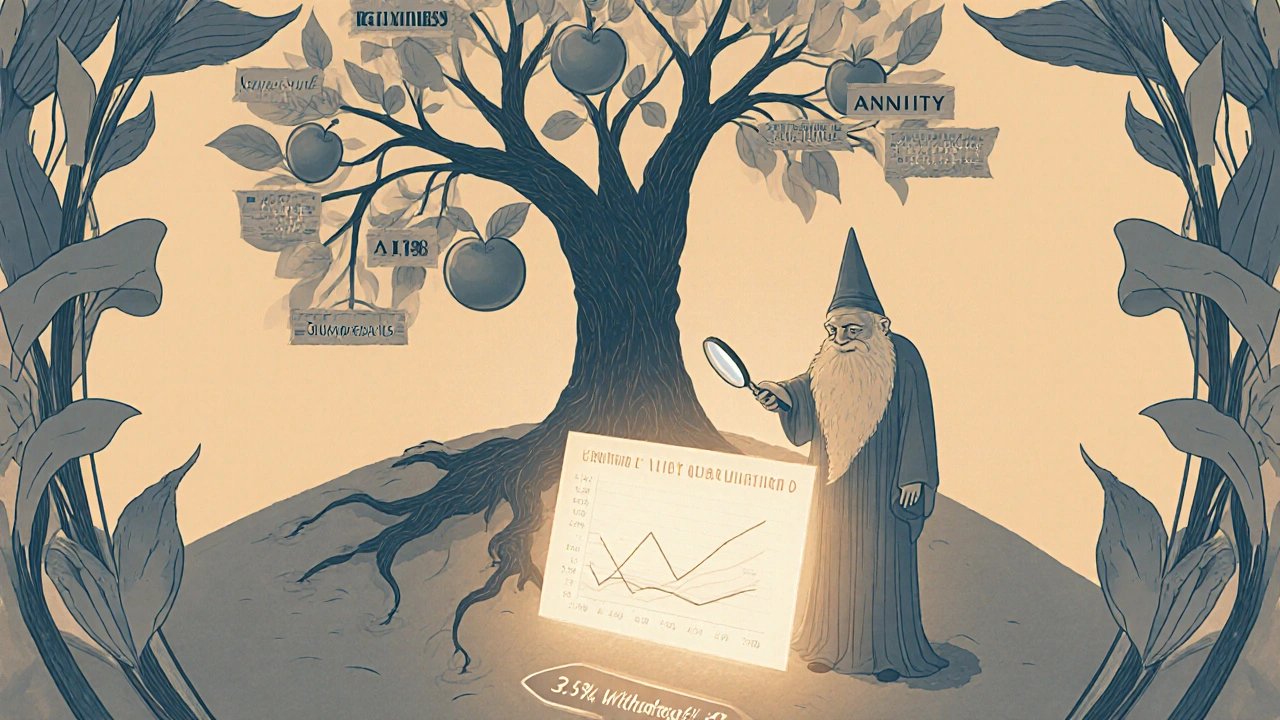4% Rule Retirement Calculator
Based on current market conditions (Shiller P/E: 30.5, Bond Yields: 4.3%), this tool calculates a modern safe withdrawal rate for your retirement portfolio.
Recommended for most retirees based on current market conditions
What the 4% Rule Really Means for Your Retirement
If you’ve heard you can withdraw 4% of your retirement savings each year and never run out of money, you’re not wrong-but you might be oversimplifying it. The 4% rule isn’t a magic number. It’s a starting point, built on data from the last century, and it’s being rewritten for today’s economy.
Here’s how it works: In your first year of retirement, you take out 4% of your total savings. If you have $1 million, that’s $40,000. The next year, you adjust that amount for inflation. If inflation was 3%, you’d take out $41,200. And so on. The idea is simple: spend a little less each year than your portfolio grows, and you’ll likely make it through 30 years or more.
This rule came from a 1994 study by financial planner William Bengen. He looked at stock and bond returns from 1926 to 1995. He found that if you held a 50/50 mix of stocks and bonds, and pulled out 4% the first year-then raised that amount every year for inflation-your money lasted 30 years in 95% of historical scenarios. That’s why it stuck. It wasn’t guesswork. It was math.
Why the 4% Rule Still Gets Used (Even by Experts)
Today, 73% of financial advisors still use the 4% rule as a baseline, according to a 2024 survey by Pensions & Investments. Why? Because it’s easy. You don’t need a spreadsheet or an algorithm. You just calculate 4% and go.
It works best for people with a balanced portfolio-40% to 60% in stocks, the rest in bonds-and no big pension. It’s also ideal if you can cut back on spending when markets drop. That’s the hidden key: flexibility.
Take a retiree in Asheville with $800,000 saved. At 4%, they get $32,000 a year. If they also get $20,000 from Social Security, they’re covering $52,000 in annual expenses. That’s above the median for retirees in North Carolina. The 4% rule gives them breathing room.
But here’s the catch: the rule assumes you’ll live 30 years in retirement. The Society of Actuaries says 25% of 65-year-old couples will have one partner live past 97. That’s longer than the rule was designed for. And with people living longer, 30 years might not be enough.
When the 4% Rule Breaks Down
Not all retirements are created equal. The 4% rule was tested on markets from 1926 to 1995. It didn’t account for what we’re seeing now: sky-high stock valuations and low bond yields.
As of October 2025, the Shiller P/E ratio-the market’s price-to-earnings ratio adjusted for inflation-is at 30.5. That’s higher than before the 2008 crash. When the market is expensive, future returns tend to be lower. That means your portfolio won’t grow as fast, and 4% might be too much.
Wade Pfau, a retirement income professor at The American College, says today’s environment demands a 3.3% withdrawal rate. Why? Because bonds, which used to pay 5-6%, now pay around 4.3%. That’s less income to cushion stock drops.
And inflation? It’s still a wildcard. In the 1970s, inflation hit 12%. The 4% rule failed then. It didn’t account for that kind of spike. Even today, if inflation jumps to 5% for a few years, your withdrawals grow faster than your portfolio. You burn through savings quicker.
Another hidden risk: sequence of returns. If you retire right before a big market crash-like in 2000 or 2008-you’re selling stocks at a loss to pay your bills. That’s deadly. David Blanchett’s 2023 study found 68% of retirement failures happen in the first five to seven years because of this.

Modern Versions of the 4% Rule: The Guardrails Approach
You don’t have to stick with the original 4% rule to benefit from it. Most experts now use a smarter version: the guardrails approach.
Here’s how it works:
- Start with 4% of your savings in year one.
- Each year, adjust for inflation-but only if your portfolio is up.
- If your portfolio drops more than 20% in a year, cut your next withdrawal by 10%.
- If your portfolio surges 20% or more, you can increase your withdrawal by half the inflation rate, not the full amount.
This isn’t science fiction. Michael Kitces, a top retirement researcher, tested this method on every market scenario since 1926. The success rate jumped from 95% to 98%. That’s huge.
Let’s say you start with $1 million and take $40,000. Then the market crashes 25% in year two. Your portfolio is now $750,000. Instead of taking $41,200 (adjusted for inflation), you take $37,080-10% less. You preserve capital. When the market recovers, you slowly rebuild your withdrawals.
This is how real retirees manage risk. They don’t treat retirement like a fixed paycheck. They treat it like a living system.
What to Do If You’re Retiring Now
If you’re retiring in 2025, here’s what actually works:
- Start lower than 4%. Try 3.5% if your portfolio is heavily in stocks and bond yields are low. You can always raise it later.
- Delay Social Security. Waiting until age 70 increases your benefit by 8% per year after full retirement age. That’s like getting a free, inflation-adjusted annuity. The Center for Retirement Research found this lets you safely withdraw up to 5.2% from your savings.
- Use dynamic withdrawal tools. Vanguard’s 2024 model adjusts the safe rate based on bond yields. At 4.3% Treasury yields, the safe rate is 4.15%. That’s a better starting point than 4%.
- Keep two years of cash. If the market crashes, you don’t sell stocks. You live off cash. This avoids locking in losses.
- Consider partial annuitization. Put 20-30% of your savings into a lifetime income annuity. Farther Finance’s 2024 survey found this boosts retiree confidence by 27%.
Also, watch Required Minimum Distributions (RMDs). Starting at age 73, the IRS forces you to withdraw more each year. At 73, it’s 3.77%. At 80, it’s 5.35%. If you’ve been using 4%, you’ll suddenly be forced to take more. That can trigger higher taxes and deplete your savings faster.

What the Experts Agree On (and What They Don’t)
There’s consensus on a few things:
- The original 4% rule is outdated for today’s markets.
- Flexibility beats rigidity.
- Sequence risk in the first five years is the biggest threat.
- Social Security and pensions are critical safety nets.
Where they disagree:
- William Bengen now says 4.7% is safe if you’re starting in 2024 with a 50/50 portfolio-but only if the Shiller P/E is below 25. At today’s 30.5, he’d lower it to 4.3%.
- Wade Pfau says 3.3% is the new floor.
- Most advisors land between 3.5% and 4.2%, depending on portfolio, age, and inflation outlook.
Bottom line: There’s no single number. But there is a framework: start conservatively, monitor your portfolio quarterly, and adjust based on market performance-not just inflation.
Common Mistakes That Break the 4% Rule
Even smart people mess this up. Here are the top three mistakes I see:
- Ignoring taxes. If your savings are in a traditional IRA or 401(k), every dollar you withdraw is taxed as income. That means your $40,000 withdrawal might only give you $30,000 after taxes. Plan for that.
- Not adjusting for healthcare. Medical costs rise faster than inflation. In your 70s and 80s, you might need $10,000-$15,000 extra per year. Budget for it.
- Thinking the rule is final. Retirement isn’t a set-it-and-forget-it plan. It’s a living strategy. Check your portfolio every quarter. If it’s down 15%, pause the inflation bump. If it’s up 20%, you can afford a small raise.
And don’t forget: housing matters. If you own your home outright, you’re ahead. If you’re renting, your cost of living is higher. That changes how much you can safely withdraw.
Is the 4% Rule Dead?
No. But the version you learned in 2010 is. The 4% rule isn’t dead-it’s evolving.
It’s not about blindly taking 4% every year. It’s about using that number as a compass. If the market’s calm and your portfolio’s growing, you can spend more. If it’s crashing, you cut back. That’s not failure. That’s wisdom.
Today’s retirees need tools, not rules. Guardrails. Flexibility. Cash buffers. Social Security timing. Annuities. These aren’t fancy tricks-they’re survival skills.
The 4% rule gave us a foundation. Now we’re building on it. And that’s how you make retirement last-not by sticking to an old number, but by staying smart, staying flexible, and staying awake to what the market’s doing.

RAHUL KUSHWAHA
This is actually super helpful. I'm from India and we don't really have 401(k)s or Social Security, but the guardrails approach makes total sense. I've been thinking of starting with 3.5% and keeping cash for 2 years just in case. Also, emojis are a must: 😅💰📉